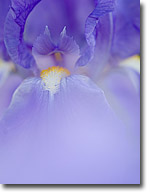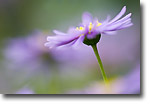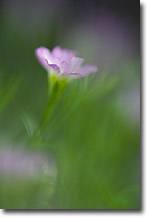Cram It! |
|
If you were to ask macro photographer, Michael Brown, what one of his favorite photo techniques is he would say 'Cram-it!' Michael is not trying to be rude. Instead, the cram-it method is the name that he has given a technique that he often uses. It is a technique that is far easier to describe than to name. The cram-it method involves shooting, through a mass of blooms or foliage, at your subject with the lens wide open (or nearly wide open). Shooting through the blooms or foliage allows for a wash of color and shape in the foreground of the subject. Due to the nature of the color wash, it is not always apparent whether the blooms are in front or behind the subject. For the sake of this article, I will refer to the technique as the “shoot through” technique. There are several NPN members who use the shoot through method including, Bill Fach, David Cobb, myself, and others.
Just as with any other photographic technique, using the shoot-through method takes some practice to make it effective. I will not say that it takes practice to be perfect in the shoot through method because so much depends on the subject in this case. You will get better as you practice though. Sometimes you will find some subjects, groups of blooms for example, which lend themselves very well to shooting through the blooms. At other times, the same type of flower or plant may not present as nice of a subject.
Subjects
Any type of flower or foliage can be used to shoot through when using the shoot through method but I do have my favorites. My favorite types of flowers to shoot through are those with delicate foliage and many small blooms. Many times when I visit the garden center I will buy a flower (or several) based just on the growth habit and size of the blooms. In actuality, any type of flower or foliage can be used to shoot through, but the small blooms just seem to work best. I shot a crammed shot of an iris recently but it is difficult to use the size of an iris bloom for a color wash. The bloom also takes a lot of area in the shot and can obscure your actual subject.
My all time favorite type of flower to shoot in a shoot-through technique is a Brachycome Hybrid. The Brachycome is a Swan River daisy. My favorite type is called the Blue Zephyr. Another find for me this year at the garden center was Baby’s Breath. I have had a lot of fun with the Baby's Breath already. Other fun plants to shoot through include lobelia, campanula, marguerite daisy, dianthus, and phlox - though I am sure that there are many others.
Planting
As previously mentioned, I find that many of my favorite cram subjects grow in large masses of blooms and are often short (or grow close to the ground). For this reason, I find that my preferred way of planting is to plant them in containers. I have some in large, tall pots, and some in shorter pots. There are several advantages to planting in containers. One is that I can move or turn the container to get a better angle on some of the blooms. Another benefit is that I am able to pick up the pots, if they are not too large, and save my back from bending over to shoot. Background and light control are also easier when flowers are planted in containers.
The Shooting
One of my favorite ways to shoot is to mount my camera on a tripod and point the lens into different areas of the plant that I am shooting while performing a “focus troll.” What I mean by focus trolling is to move the lens through the focal range that I would expect to find focal points in, to see if anything jumps out at me. Most often, the camera will not be in the ideal or final position but you will be able to see a possible composition out of the corner of your eye. With digital, experimentation is also a good idea when using the shoot through method.
The only other advice that I can give about shooting through foliage is to look for areas in the plant where there are a lot of blooms together. It can also be helpful when shooting if you are able to get down on the same level of the blooms, or even underneath them (this is one other reason that a plant in a container works well).
Fixing (Some May Say Cheating)
I am not going to go into a philosophical discussion about the use of the clone tool at this time – as I am sure that cloning can and will be debated in other places and times. What I am going to say is that sometimes with a technique such as shooting through, there are extra elements in your image that in most cases may not need removal, but may need softening. You will have to decide how you feel about the use of the clone tool and proceed accordingly.
My favorite use of the clone tool with a crammed image is to take the clone tool and set it at a large setting – larger than the area that you are trying to “fix.” Take the opacity on the tool and set it to 50 or 60%. Sample a soft area of the image, and then apply that to the area that you want to soften. This will allow the element to still show through, but will take the edge off of it, and will blend it in better with the rest of the image.
I hope that this little look into the cram-it (shoot through) method will give you some new ideas in creating compelling and creative floral photographs. Next time someone asks you to explain how you are shooting then you can say, “Cram-it!”
Comments on NPN flower photography articles? Send them to the editor. NPN members may also log in and leave their comments below.
Nathan Buck resides in Lehi, Utah with his wife, Charisma, and their three young sons. Nathan is a hobbyist photographer whose other favorite pastime is spending time with his family; he finds that photography allows him to do both. Nathan enjoys shooting a wide range of subjects, with flora being at the top of the list (at least for now, his wife says).



